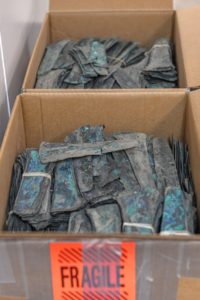 A collection of 3,990 Mesoamerican copper coins dating to between 1200 and 1500 has been returned to Mexico. The coins belonged to a US private collector who acquired them at a Texas coin fair in the 1960s.
A collection of 3,990 Mesoamerican copper coins dating to between 1200 and 1500 has been returned to Mexico. The coins belonged to a US private collector who acquired them at a Texas coin fair in the 1960s.
Mexican authorities notified the FBI of the existence of the coins in 2013 when they were taken to Spain for an auction. Mexico’s National Institute of Anthropology and History (INAH) then began authenticating the coins in order to request their return.
As both countries were by then signatories to the UNESCO convention (Mexico in 1972 and the United States in 1983), the return process was completed six years later.
[Mexican Consulate in Miami spokesperson Jessica] Cascante did not divulge the name of the collector who obtained the coins in the 1960s, but said that he did so before it constituted a crime and turned them in voluntarily.
 The press coverage describes the coins as “tongue-shaped” but in fact they were shaped like miniature axes. They were hammered from a copper-arsenic alloy blank into the shape of a hachuela, a hatchet or small axe, hence the term axe-monies. They were beaten so thin that they could easily be stacked and bundled, easily circulated and easily hoarded. Indeed, most of them have been found in hoards or caches, often in graves, sometimes still bound in packets or bundles. This collection was likely a single hoard.
The press coverage describes the coins as “tongue-shaped” but in fact they were shaped like miniature axes. They were hammered from a copper-arsenic alloy blank into the shape of a hachuela, a hatchet or small axe, hence the term axe-monies. They were beaten so thin that they could easily be stacked and bundled, easily circulated and easily hoarded. Indeed, most of them have been found in hoards or caches, often in graves, sometimes still bound in packets or bundles. This collection was likely a single hoard.
Axe-monies arrived in western Mexico around 1200. The metalcraft was apparently imported from the Andes (modern-day Ecuador and Peru), where arsenical copper was hammered into axe-like shapes (longer styles in feather shapes have been found at Andean sites) with the same thin, stackable properties. They are archaeologically significant, therefore, not just for their age, currency value and general coolness as axe-shaped coins, but because they attest to an exchange of monies and metallurgic technology between the ancient Mexican and Andean peoples.
 Chroniclers from the 16th century document axe-monies used as tributes — one Geurrero province owned the Aztec king 80 hachuelas a year — and depict merchants at the tiyānquiztli, the outdoor markets held in towns’ central squares at least weekly, carrying objects that look like hachuelas. A 1528 inventory of tribute from Michoacán stored in the arsenal of Mexico City lists 113 cases of copper axe-monies. In a 1548 letter, Francisco López Tenorio, the Spanish governor of what is now Oaxaca city, four new hachuelas were worth five Spanish reales, but once they were worn down, their value plummeted to 10 for one real. They would then be collected, melted down and remade.
Chroniclers from the 16th century document axe-monies used as tributes — one Geurrero province owned the Aztec king 80 hachuelas a year — and depict merchants at the tiyānquiztli, the outdoor markets held in towns’ central squares at least weekly, carrying objects that look like hachuelas. A 1528 inventory of tribute from Michoacán stored in the arsenal of Mexico City lists 113 cases of copper axe-monies. In a 1548 letter, Francisco López Tenorio, the Spanish governor of what is now Oaxaca city, four new hachuelas were worth five Spanish reales, but once they were worn down, their value plummeted to 10 for one real. They would then be collected, melted down and remade.
Question
How much modern day money would an axe be equivalent to?